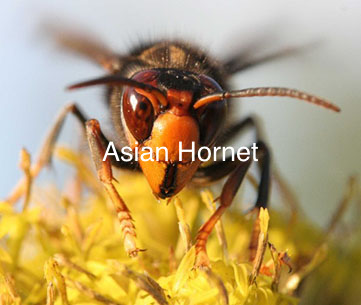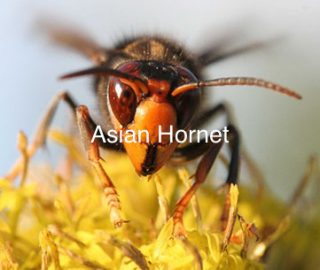 Another glorious month of sunny weather, no road traffic and no planes in the sky. Lockdown has a lot going for it in my situation, though I know it’s tough on a huge number of people. The bees love it too! The air is clean and unpolluted and they have all been noticeably calmer and more industrious during the lockdown. The colonies are strong, they are all in good health and I am running headless to try to keep up with their demands for more laying space for the queen or more storage space for their nectar (as well as sorting out other problems that crop up, as they do in beekeeping!).
Another glorious month of sunny weather, no road traffic and no planes in the sky. Lockdown has a lot going for it in my situation, though I know it’s tough on a huge number of people. The bees love it too! The air is clean and unpolluted and they have all been noticeably calmer and more industrious during the lockdown. The colonies are strong, they are all in good health and I am running headless to try to keep up with their demands for more laying space for the queen or more storage space for their nectar (as well as sorting out other problems that crop up, as they do in beekeeping!).
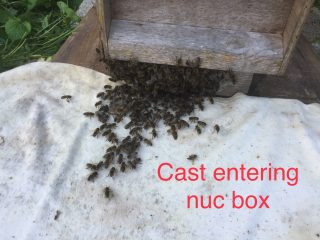 The nucs are coming on a treat, with their queens having had ideal conditions for mating. These nucs are therefore developing slowly into colonies, so that by the end of the season they will be large enough and with sufficient stores to see them through the winter.
The nucs are coming on a treat, with their queens having had ideal conditions for mating. These nucs are therefore developing slowly into colonies, so that by the end of the season they will be large enough and with sufficient stores to see them through the winter.
Also, the swarming season has started. I picked up my first swarm (actually a cast, ie a secondary swarm with a virgin queen) in the first week of May and because they were only a cast (so not that many bees), I hived them in a nuc box. The virgin queen has since mated and is laying successfully and the bees are drawing down comb from the foundation strips I gave them.
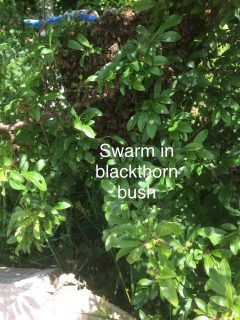 Two weeks later, I was checking my apiary on my lunchtime walkabout and found a swarm issuing from one of my hives, gathering in a blackthorn bush about 1 metre away from the hive. This in itself is most unusual as swarms normally fly about 25 metres from the hive before pitching in a tree or bush, but no, it had to be the nearest object in which they would cluster! Not only that but there was a second, smaller cluster about two feet away in the same bush!
Two weeks later, I was checking my apiary on my lunchtime walkabout and found a swarm issuing from one of my hives, gathering in a blackthorn bush about 1 metre away from the hive. This in itself is most unusual as swarms normally fly about 25 metres from the hive before pitching in a tree or bush, but no, it had to be the nearest object in which they would cluster! Not only that but there was a second, smaller cluster about two feet away in the same bush!
I had no doubt this second cluster was related to the first but captured them separately in two boxes which I then placed side by side on my white hiving cloth. There was a lot of fanning outside the box with the larger swarm in, indicating a queen was inside and the rest of the swarm should “come on in”, but the smaller box had no fanning bees. click video link IMG_3039
By the end of the day the smaller box was empty and the bees had rejoined their main swarm in the one large box. I then hived this into my Kenyan top bar hive to which they have taken enthusiastically.
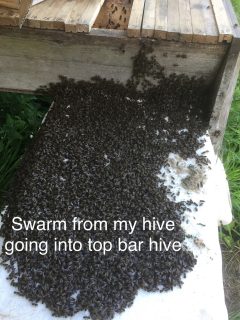
When I went to the hive from which the swarm had emerged, I immediately noticed there was no brood present – plenty of pollen and nectar (and bees) but no brood! This meant that the swarm had exited the hive knowing full well that there was no possibility the remaining bees could raise a new queen! Most bizarre! Basically, the bees had absconded – but why, and why not all of them? Further examination gave me an inkling as to what had been going on – the hive was honey bound! There were full frames of honey, full frames of pollen but no laying space for the queen, so the bees had buzzed off to find a more suitable home. Can’t say I blame them, really.
In the absence of eggs or young larvae though, as I said, there was no way the remaining bees could raise a new queen, so I inserted a comb of eggs and young larvae from another colony to give them the necessary material to be able to do so. I will report on progress next time.
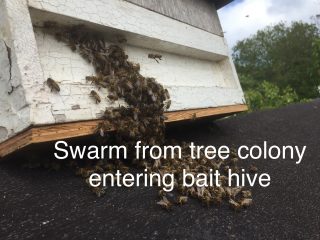 My third swarm was from the wild tree colony I referred to last month. After placing the bait hive on the shed roof at my friend’s house, there were bees examining it by the end of the first day, so they knew it was there – always a good sign.Two weeks later, I had the call I was hoping for – a swarm had arrived click video link IMG_3070 So exciting! These bees had lived in the wild, with no beekeeper intervention, for a number of years apparently, so they were managing their own health and Varroa issues by themselves.
My third swarm was from the wild tree colony I referred to last month. After placing the bait hive on the shed roof at my friend’s house, there were bees examining it by the end of the first day, so they knew it was there – always a good sign.Two weeks later, I had the call I was hoping for – a swarm had arrived click video link IMG_3070 So exciting! These bees had lived in the wild, with no beekeeper intervention, for a number of years apparently, so they were managing their own health and Varroa issues by themselves.
This is really quite significant, as I had already built up an apiary at home which has been chemical and treatment free for 10 years, so my bees had already developed their own coping strategy for Varroa – this colony would therefore help to supplement that during swarming time in years to come and hopefully the genetics would spread amongst other colonies in the area. I brought the bees home that night and hived them in a standard brood box, which they took to like ducks to water. After 48 hours I started feeding them, so they could draw new comb from the starter strips I had placed in the frames, and they are slurping the feed down as fast as I can provide it!
Very pleased with the outcome of this exercise. Needless to say, the bait hive has been returned to the shed roof in the hope of attracting any after-swarms, and even while I was locating it on the roof there were two or three bees exploring what I was doing, as if they knew the bait hive had been there and were just waiting for its return! Time will tell!
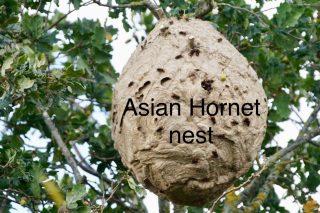 I mentioned the book by Storch last month, “At the Hive Entrance”. Well, as ever applying Storch’s teachings in my visits the apiary, I noticed one hive was very much less active than others with few flying bees and no pollen going in, so decided to take a look. Strangely enough, once again there was no brood – no eggs, no larvae and no sealed brood – the colony must have lost its queen. I examined each comb meticulously, looking for the queen, but to no avail – she was gone. Or was she? The bees were perfectly calm and accepting of my interference, as if they knew they had a queen – or maybe knew that I was there to help them. So help them I did, again by providing a comb of eggs and young larvae, from another colony, from which they could produce a new queen.
I mentioned the book by Storch last month, “At the Hive Entrance”. Well, as ever applying Storch’s teachings in my visits the apiary, I noticed one hive was very much less active than others with few flying bees and no pollen going in, so decided to take a look. Strangely enough, once again there was no brood – no eggs, no larvae and no sealed brood – the colony must have lost its queen. I examined each comb meticulously, looking for the queen, but to no avail – she was gone. Or was she? The bees were perfectly calm and accepting of my interference, as if they knew they had a queen – or maybe knew that I was there to help them. So help them I did, again by providing a comb of eggs and young larvae, from another colony, from which they could produce a new queen.
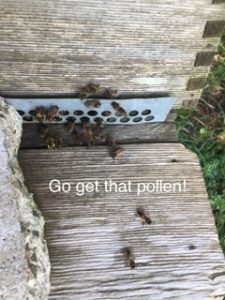 One week later, I went back to the hive to check for queen cells – nothing! That can only mean there is a queen present (it could mean laying workers but since there were no eggs being laid then that possibility was discounted). Also, the demeanour of the bees was such that I could tell there was a queen in the hive, even if I couldn’t find her. So I continued my search, going through each comb slowly and resolutely, until I came to the last one. I should have started there because on the bottom of that comb, there was the queen in all her majesty. There was a queen in the hive after all – she was just having a break from laying (queens can lay up to 2,000 eggs a day in the height of the season, so it’s no wonder they need a break from time to time!). I closed down the hive and left them to it. Hopefully, the pheromones from the open brood I had inserted and the vigour of the bees in feeding the open larvae would kick-start the queen into laying again. I would give it another week and see what transpires.
One week later, I went back to the hive to check for queen cells – nothing! That can only mean there is a queen present (it could mean laying workers but since there were no eggs being laid then that possibility was discounted). Also, the demeanour of the bees was such that I could tell there was a queen in the hive, even if I couldn’t find her. So I continued my search, going through each comb slowly and resolutely, until I came to the last one. I should have started there because on the bottom of that comb, there was the queen in all her majesty. There was a queen in the hive after all – she was just having a break from laying (queens can lay up to 2,000 eggs a day in the height of the season, so it’s no wonder they need a break from time to time!). I closed down the hive and left them to it. Hopefully, the pheromones from the open brood I had inserted and the vigour of the bees in feeding the open larvae would kick-start the queen into laying again. I would give it another week and see what transpires.
Funnily enough, I then had a call from a former beekeeping student of mine who had exactly the same problem. He had done exactly what I had done (he learnt well!) but no sign of queen cells. I suggested he gave it another week, as I was doing, and we’d talk again. When I went back to my hive a week later, there it all was, brood everywhere – she was back in business. A call from my friend then informed me that his queen too was back in lay, though he hadn’t seen her yet, so we are two very happy (and relieved!) beekeepers.
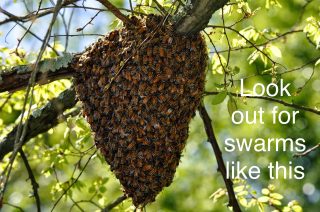 I think that’s enough for now. Keep your eyes open for more swarms, please, and give me a call if you see a clump of bees hanging quietly on a branch. I, or another beekeeper, will come and collect them to prevent them from flying off and finding a nice chimney or roof space in which to build their new home. Also, look out for the Asian Hornet which, though it hasn’t come this far down in the UK yet, might well turn up one day, so we need to be pro-active in preventing its incursion.
I think that’s enough for now. Keep your eyes open for more swarms, please, and give me a call if you see a clump of bees hanging quietly on a branch. I, or another beekeeper, will come and collect them to prevent them from flying off and finding a nice chimney or roof space in which to build their new home. Also, look out for the Asian Hornet which, though it hasn’t come this far down in the UK yet, might well turn up one day, so we need to be pro-active in preventing its incursion.
In the meantime, enjoy the glorious, sunny weather and rejoice in our good fortune in living in such a beautiful county.
Colin Rees 01872 501313 07939 971104 colinbeeman@aol.com

